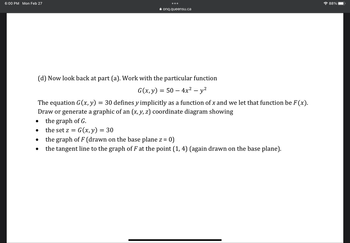(b) Construct the question text for a problem with exactly the same format as (a) but one dimension higher. That is: - Your question text will include two functions w = G(x, y, z) and z = F(x, y); - You have some freedom here in choosing numerical values for your version of the problem, e.g. you can define the 3D point of interest in the higher dimension question in any way you chose; - All the object names should be updated appropriately, e.g. if a line in the original problem becomes a plane when you added the new dimension, your question text should refer to a 'plane'; Example: your question text would start with the text "Let w be a function of x, y and z: W = G(x, y, z). Suppose that..." Note: in part (c),you will be solve this p () the problem Solve
(b) Construct the question text for a problem with exactly the same format as (a) but one dimension higher. That is: - Your question text will include two functions w = G(x, y, z) and z = F(x, y); - You have some freedom here in choosing numerical values for your version of the problem, e.g. you can define the 3D point of interest in the higher dimension question in any way you chose; - All the object names should be updated appropriately, e.g. if a line in the original problem becomes a plane when you added the new dimension, your question text should refer to a 'plane'; Example: your question text would start with the text "Let w be a function of x, y and z: W = G(x, y, z). Suppose that..." Note: in part (c),you will be solve this p () the problem Solve
Advanced Engineering Mathematics
10th Edition
ISBN:9780470458365
Author:Erwin Kreyszig
Publisher:Erwin Kreyszig
Chapter2: Second-order Linear Odes
Section: Chapter Questions
Problem 1RQ
Related questions
Question

Transcribed Image Text:(a) Let z be a function of x and y: z = G(x, y). Suppose that G(1,2)= 30. Let the tangent plane to
the graph of G at (1, 2, 30) be
z = 30 + 2(x − 1) − 3(y − 2)
The equation G (x, y) = 30 defines y implicitly as a function of x and we let that function be F(x).
Find the tangent line to the graph of F at the point (1, 2).

Transcribed Image Text:(b) Construct the question text for a problem with exactly the same format as (a) but one dimension
higher. That is:
- Your question text will include two functions w
=
G(x, y, z) and z = F(x, y);
- You have some freedom here in choosing numerical values for your version of the problem, e.g. you can
define the 3D point of interest in the higher dimension question in any way you chose;
- All the object names should be updated appropriately, e.g. if a line in the original problem becomes a
plane when you added the new dimension, your question text should refer to a 'plane';
Example: your question text would start with the text “Let w be a function of x, y and z:
w = G(x, y, z). Suppose that..."
Note: in part (c), eithe
()
problem
solve
the
structing.
Expert Solution
This question has been solved!
Explore an expertly crafted, step-by-step solution for a thorough understanding of key concepts.
Step by step
Solved in 2 steps

Follow-up Questions
Read through expert solutions to related follow-up questions below.
Follow-up Question

Transcribed Image Text:6:00 PM Mon Feb 27
●●●
✰onq.queensu.ca
(d) Now look back at part (a). Work with the particular function
G(x, y) = 50 — 4x² − y²
-
●
The equation G(x, y) = 30 defines y implicitly as a function of x and we let that function be F(x).
Draw or generate a graphic of an (x, y, z) coordinate diagram showing
the graph of G.
the set z = G(x, y) = 30
the graph of F (drawn on the base plane z = 0)
the tangent line to the graph of F at the point (1, 4) (again drawn on the base plane).
88%
Solution
Recommended textbooks for you

Advanced Engineering Mathematics
Advanced Math
ISBN:
9780470458365
Author:
Erwin Kreyszig
Publisher:
Wiley, John & Sons, Incorporated

Numerical Methods for Engineers
Advanced Math
ISBN:
9780073397924
Author:
Steven C. Chapra Dr., Raymond P. Canale
Publisher:
McGraw-Hill Education

Introductory Mathematics for Engineering Applicat…
Advanced Math
ISBN:
9781118141809
Author:
Nathan Klingbeil
Publisher:
WILEY

Advanced Engineering Mathematics
Advanced Math
ISBN:
9780470458365
Author:
Erwin Kreyszig
Publisher:
Wiley, John & Sons, Incorporated

Numerical Methods for Engineers
Advanced Math
ISBN:
9780073397924
Author:
Steven C. Chapra Dr., Raymond P. Canale
Publisher:
McGraw-Hill Education

Introductory Mathematics for Engineering Applicat…
Advanced Math
ISBN:
9781118141809
Author:
Nathan Klingbeil
Publisher:
WILEY

Mathematics For Machine Technology
Advanced Math
ISBN:
9781337798310
Author:
Peterson, John.
Publisher:
Cengage Learning,

